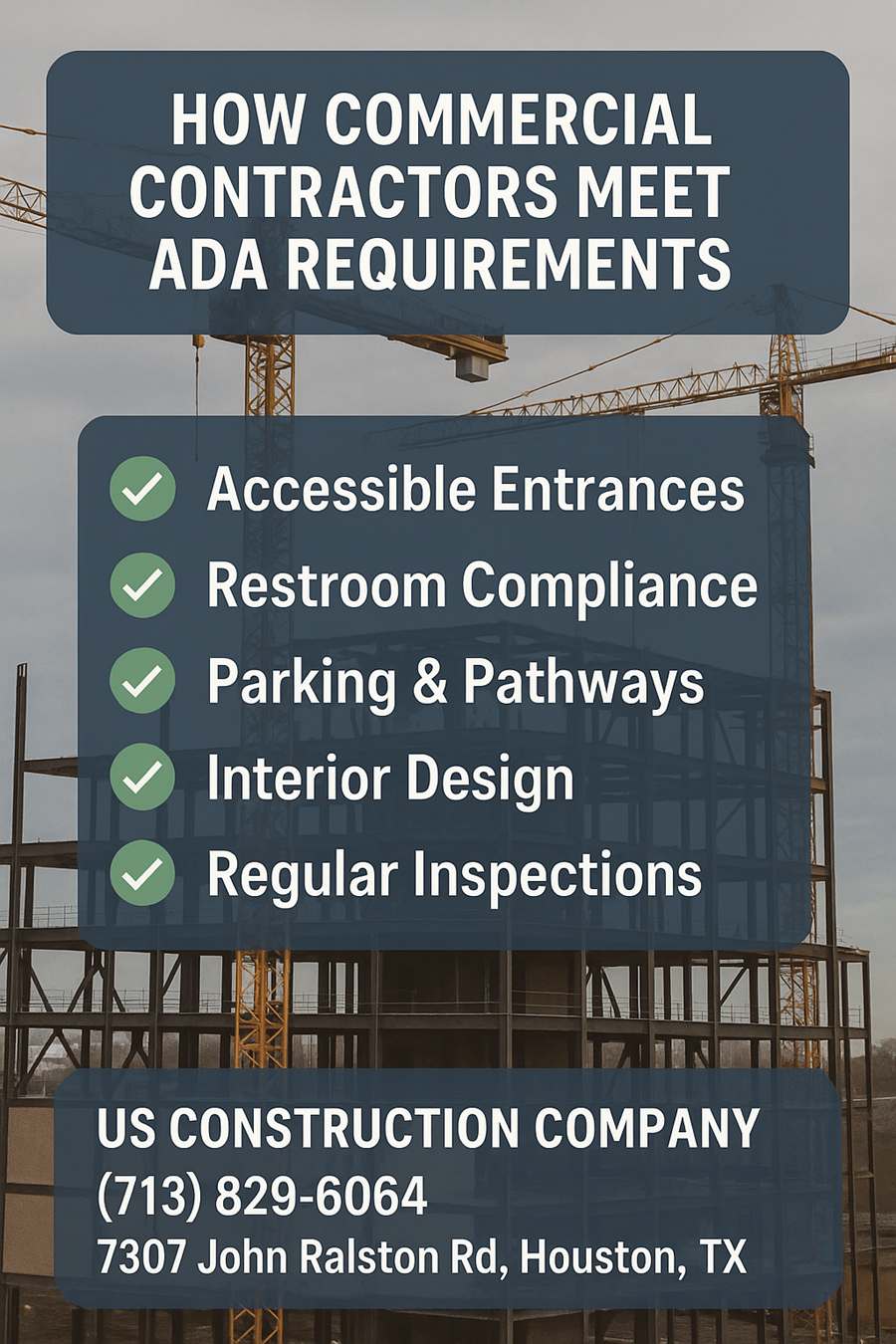Suppose you are a contractor or property owner who wants to construct a commercial building. In that case, it is essential to have a deep understanding of the Americans with Disabilities Act (ADA). The ADA is a legal framework that covers the design features required for the convenience of handicap persons with disabilities. Stay with us to gain insight into how commercial contractors meet ADA requirements.
US Construction Company integrates design features that make businesses and public facilities accessible to people with disabilities. We meet ADA compliance for wheelchair ramps, clear signage, and accessible restrooms. Such measures delight inhabitants and save them from the fines the local governments impose.
What are the ADA Requirements for Commercial Construction?
Guidelines of the Americans with Disabilities Act (ADA) are applicable in long-term development. For Houston commercial contractors, adhering to these rules means creating welcoming, practical, and legally compliant spaces. Here we give an overview of the ADA general requirements:
Accessible Entrances
A property’s public gateways must be no less than 60% wheelchair-accessible.
- Where stairs are present, doorways should have ramps or elevators.
- Critical interior areas should be linked by clear and well-defined walkways at least 36 inches wide.
- Design surfaces must be flat, solid, and non-sloppy.
Parking and Vehicle Access
ADA-approved parking zones must be comparable to the total number of parking slots in commercial establishments.
- spots should have a 5-foot entrance corridor and be 8 feet broad (an 8-foot corridor is necessary for wheelchair-accessible spots).
- Located nearest to exits that are accessible.
- The International Symbol of Accessibility (ISA) should be effectively followed.
Doors, Hallways, and Maneuvering Space
When fully opened, doorways must have a minimum of 32 inches of unobstructed area.
- Door knobs must be operated with a single hand without tight squeezing, twisting, or grabbing.
- Passageways and aisles should have at least 36 inches in between.
- Wheelchairs should have an adequate maneuvering radius in such areas as restrooms and corridors, which usually have 60 inches.

Restrooms Facilities
Each floor must have a minimum of one ADA-compliant restroom. Attributes need to consist of:
- Toilet grab bars in restrooms.
- The sink should be no higher than 34 inches off the ground.
- Mirrors and faucets are positioned no higher than 48 inches.
- Entryways that can be pulled or pushed open.
Ramps and Elevators
The stairs should be in a ramp structure with a 1:12 inclination ratio. This means that for a 1-inch slope, the flat area should be 12 inches long.
- For protection, there are top and bottom platforms.
- With few alternatives for lower structures, elevators are necessary in buildings with multiple levels.
- Controls and knobs on elevators must be within wheelchair accessibility.
Signage and Direction Boards
Clear and enlarged symbols must be used on permanent room signage.
- Fonts that are simple for readers and have stark contrast are required.
- Signs should be placed regularly and erected between 48 and 60 inches above the ground.
Reach Ranges and Controls
The height of buttons, thermostats, and bulbs shall not exceed 48 inches from the ground.
- A lower extent of less than 15 inches is not recommended.
- Ensures people with disabilities can reach it.
Meeting or Seminar Zones
Wheelchair-accessible seating sections must be included in regular seating areas in meeting venues (auditoriums, seminars, and stadiums) rather than being separated.
- Additional seats should be provided near accessible areas.
- Accessible speech venues, theaters, and stages are also essential.
Communication Features
In addition to auditory alerts, safety systems must have visual notifications, such as blinking lights.
- Large gathering spaces must have hearing aid devices.
- There must be helplines and phones that are accessible.
Pathways During Renovations
When structural alterations are made to previous buildings, Houston commercial contractors should integrate ADA-compliant features and update the hallways, stairways, toilets, and entrance areas.
Why ADA Standards Matter
- Avoid penalties of $75,000 for the first time; if non-compliance is continued, it will reach $150,000.
- A greater variety of clients, workers, and customers are drawn to ADA featured buildings.
- Promoting usefulness and equal chances for all is the goal of inclusivity.
Role of Commercial Contractors in ADA Compliance
Obviously, affordable Houston commercial contractors are essential to ensuring that ADA regulations are appropriately applied during building or remodelling projects. They serve as the link between designs, regulatory standards, and actual implementation.
Understand ADA Standards
Contractors must possess a thorough understanding of the ADA Rules. This entails knowing the driveways, stairways, signage, and entrances specifications. Their knowledge guarantees that designs are converted into legally compliant buildings.
Collaborate with Designers
Before the building starts, they collaborate with different personnel and architects to examine plans. US Construction Company ensures that arrangements, slopes, and proportions adhere to ADA regulations, which avoids subsequent, expensive rework.
Site Preparation and ADA Planning
Contractors assess site characteristics, including landscaping, surfaces, and entrances, to guarantee wheelchair access and easy passage for everyone.
Integrate During Construction
Contractors supervise building procedures to guarantee compliance at every level. They manage from installing ramps with the necessary slopes to grabbing bars in restrooms at ADA-approved dimensions.
Conduct Compliance Inspections
To find any discrepancies in ADA legality, contractors perform routine inspections before and after construction. Additionally, they get the location ready for governmental licenses or external inspections.
Renovate Older Buildings
Many older business structures require ADA remodelling. To bring facilities up to standard, contractors oversee these improvements, including repainting parking spaces, installing accessible toilets, or enlarging doorways.
Client Guidance and Documentation
Remarkably, to shield owners from legal issues, professionals also inform customers of their continuing obligations under the ADA and offer documents to confirm compliance.
Best Practices for a US Construction Company Follow
US Construction Company is one of the most experienced residential, commercial, and industrial contractors worldwide and in Houston. They adopt innovative and advanced technologies to lead this industry.
ADA-Compliant Fixtures
Every component and installation of the ADA-approved structures has different features. These may include user-friendly faucets, lighting, flooring, and other fixtures. Lever-shaped door handles are suitable for people with restricted hand mobility, while slip-resistant tiles lower the chance of falls.
Training Accessibility Guidelines
Design is only one aspect of ADA conformity; all employees must know accessibility guidelines. Designers, engineers, and managerial staff are among the project teams. The Best Houston commercial contractors routinely train to identify and appropriately apply ADA design aspects while building.
Partner with ADA Consultants
Many subcontractors work with trained ADA experts to prevent compliance issues. These professionals provide reliable opinions, survey the area, and ensure the designs comply with regulations before the building commences.
Updated with ADA Amendments
As legislation changes and technology advances, so do ADA rules. Leading companies track updates from the Department of Justice (DOJ) to stay their personnel informed. By organizing, buildings are kept accessible for many years, and expensive rework is avoided.
Common Challenges Contractors Overcome
Indeed, the construction business is quite challenging with minor profit margin ratios. Thus, experts always search for reliable, practical, and cost-effective approaches. Here are some technical issues Houston commercial professionals face during ADA-compliant renovation projects.
Infrastructure Limitations
The building structure necessary to facilitate accessibility modifications was missing before the ADA’s implementation in 1990.
Obsolete restroom plans, steep stairs, and restricted halls can cause compliance problems. Contractors innovate to upgrade existing construction to keep its worth and aesthetics intact.
Budget Constraints
ADA-compliant features can be expensive to install in old structures. It may involve major structural changes that will exceed small businesses’ budgets.
Knowledgeable contractors assist customers in prioritizing essential renovations. They also direct companies to local awards and government tax reductions that help defray compliance expenses.
Balancing Functionality
Likewise, investors experience a decrease in commercial assets’ resale value as ADA-compliant features impact the exterior of the building.
It is a fact that can be defeated by ensuring that accessibility is coupled with attractiveness due to creative designs. For instance, ramps with architectural integration, ornamental handrails, and fashionable yet legal signage improve both use and appearance.
Best Houston Commercial Contractor Near Me
ADA regulations don’t have to be difficult to understand. Our skilled group of Houston commercial contractors has focused knowledge and expertise.
US Construction Company preserves building functionality, security, visual appeal, and legal conformity. When you work with us, you can rest easy knowing that your facility is operational and fully compliant.
FAQs
Q 1. What is the cost of constructing an ADA-compliant business facility?
The extent, structure, and condition of the building influence the price. Conformance with the ADA is typically incorporated into the design of new builds, which is more economical. Modifying is expensive. For maximum reliability, contractors usually conduct an accessibility assessment before cost estimation.
Q 2. Are older structures excluded from ADA regulations?
Older structures are not always excluded. The ADA requires “quickly obtainable” modifications that can be performed without effort or expense. For instance, grab bars, lowered light switches, or resized doorways could be necessary. Complete exclusions are uncommon and often only occur in situations when structural alterations would cause serious concern.
Q 3. Who would enforce ADA compliance on business projects?
In the United States, the Department of Justice (DOJ) is authorized to approve and inspect the ADA compliance codes of commercial construction. If you experience delays and inconveniences, you can file a complaint.


Leave A Comment